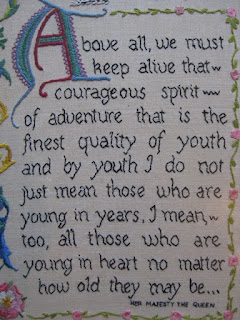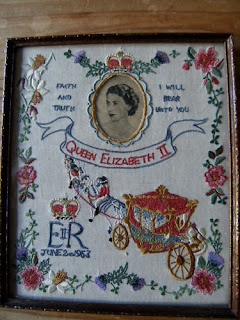With the Queen's Diamond Jubilee in 2012, designers and crafters and others are already gearing up with ideas. Here's a roundup of some designs, news, exhibitions and ideas I've found recently. I'm sure there will be more to document as the jubilee draws closer, which is why this blog entry is labelled as Diamond Jubilee (I). You can also navigate to entries of interest by using the tags on each entry.
From Katiemae Designs you can obtain the chart for this blackwork embroidery:
Read more and order the chart here:
http://katiemaedesigns.info/Samplers.html
It costs £5 (check on the site re postage costs to your location).
This is the same designer who made a detailed blackwork chart of Westminster Abbey for the royal wedding of William and Kate (as shown in my blog entry about W&K royal wedding samplers).
See it and buy the chart here:
http://katiemaedesigns.info/Buildings_and_Landmarks.html
***
Embroidery teacher Jacqui McDonald, who teaches at the Royal School of Needlework, blogs that she is working on a Diamond Jubilee design involving stumpwork, blackwork and goldwork. No image of the design as yet.
Read the blog entry here:
http://www.hand-embroidered.co.uk/blog/read_34020/jubilee-celebrations.html
Read about the three classes in January 2012 which will teach the design:
http://www.hand-embroidered.co.uk/events_71565.html
Later in 2012 there will be a class showing how to mount your embroidery in a Jubilee Casket.
[Is is just me, or does 'casket' just have too much funereal association??? what with the Queen not being precisely young and all, even if her mother did live to be over 100 years old...]
***
Glimpses of Blighty is a competition being run by Madeira Threads and ICHF in the UK. Here is their description:
‘Blighty’ is a slang term for Britain, first used in the latter days of the British Raj. It is now more commonly used as a term of endearment by the expat British community or those on holiday to refer to home.
With the world’s eyes focused on Great Britain, firstly with the Royal Wedding last April, and with the Olympics and the Queen’s Diamond Jubilee next year – let your imagination run wild and embroider all that is ‘Best of British’ both past and present, and you could WIN one of our fabulous prizes! There’s a prize for each Category winner and a superb prize for the overall winner!
It will be interesting to see what works might come from this.
Read more here:
***
Jacksons of Hebden Bridge, who sell kits for church kneelers, have several designs in kneelers and cushions telated to the diamond jubilee:
Kneeler above, tent-stitch cushion below.
Kneeler above, cross-stitch cushion below.
The final one, shown below, disappoints me a tad. The energy and verve of the diamond jubilee logo have, to my mind, lost a lot of their charm by being 'regularised' into straighter geometry. Not necessary, to me. Here's the original logo, followed by Jacksons of Hebden Bridge's kneeler and cros-stitch cushion designs.
The company sells kits of their designs. Visit their selection of jubilee designs here:
http://churchkneelers.com/jubilee_shop.php
Prices range from £35.95 to £59.95 for a cushion kit, £42.25 to £52.95 for a kneeler kit. Check on the site for postage costs to your location.
***
A background briefing document from the Royal School of Needlework advises:
The RSN has an extensive collection and archive and to enable more people to see
some of its holdings, it offers themed tours. For 2012, in celebration of Her Majesty
The Queen’s Diamond Jubilee the RSN’s theme will be
Royal RSN
Read the document here:
http://www.royal-needlework.org.uk/images/uploaded/Documents/Events/rsn%2Bbackgound%2Binformation%2B29.04.pdf
Keep an eye on the site for more information on jubilee exhibitions/events. The RSN may well produce a jubilee sampler design for sale - they did a whitework one for the recent royal wedding (see the royal wedding samplers blog entry I wrote in April 2011 for more info).
***
This crown stencil from Stencil Library has embroidery/stitching potential, possibly with cotton thread/gold thread/beading/as a wool-stitched tapestry...

They suggest it could be stencilled over a Union Jack design too.
Pricing: The size of the crown is 21cms high by 20cms wide (that is roughly 8 inches) but you can have it made to other sizes. Just ask. The price of the new crown at 21cms high is £18.50. UK postage is free. Add £3 postage for EU countries and £5 for everywhere else in the world. Packages are sent by Royal Mail.
Read more on the Design Inspiration blog here:
http://designinspiration.typepad.com/design_inspiration_planet/2011/04/an-exclusive-crown-stencil.html
In another blog entry, they show how to use a stencil to create a tapestry design on canvas:
http://designinspiration.typepad.com/design_inspiration_planet/2009/06/stencils-and-tapestry.html
Link for Union Jack stencil:
http://www.stencil-library.com/docs/exclusives05.html
***
Trend BIble sees "British Street Party" as a coming trend, influenced by the diamond jubilee and the London Olympics.
See all their images here:
http://www.trendbible.co.uk/blog/news/news-top-drawer-autumn-trend-feature/
Question for self: what sorts of samplers/embroideries will be around for the London Olympics, and do they fall within or outside my collection development/blog scope policy??...)
***
Finally...
Not directly related to embroidery/samplers, but of interest if you are in the UK and able to visit is the touring exhibition
The Queen: Art and Image.
This is a description of it:
To mark the Queen’s Diamond Jubilee in 2012, the National Portrait Gallery is staging an innovative touring exhibition bringing together sixty of the most remarkable and resonant images of Elizabeth II. This will be the first National Portrait Gallery exhibition to tour to British venues before being shown in London, opening in Edinburgh in June, Belfast in October and Cardiff and London in 2012.
The exhibition includes formal painted portraits, official photographs, press images and works by contemporary artists and explores the evolution of the way The Queen has been portrayed during the sixty years of her reign. Artists and photographers include Pietro Annigoni, Cecil Beaton, Lord Lichfield, Andy Warhol, Lucian Freud and Gerhard Richter and their works are accompanied by archival material – from film footage to postage stamps.
The Queen: Art and Image celebrates and explores the startling range of artistic creativity and media-derived imagery that the Queen has inspired. It also probes the relation of this imagery to a world of changing values during a reign that has engaged the attention of millions.Read more here:
http://www.npg.org.uk/whatson/exhibitions/2012/the-queen-art-and-image.php
Catalogue book (harcover or paperback) is available - details here:
http://www.npg.org.uk/shop/shop-list.php?showProductDetails=4819
Or if you want postcard books, badges and more:
http://www.npg.org.uk/shop/shop-list.php?cat=royalty&inx=1
***
Please leave a comment to advise of any other useful related links, patterns, designs or kits related to the diamond jubilee.

















































